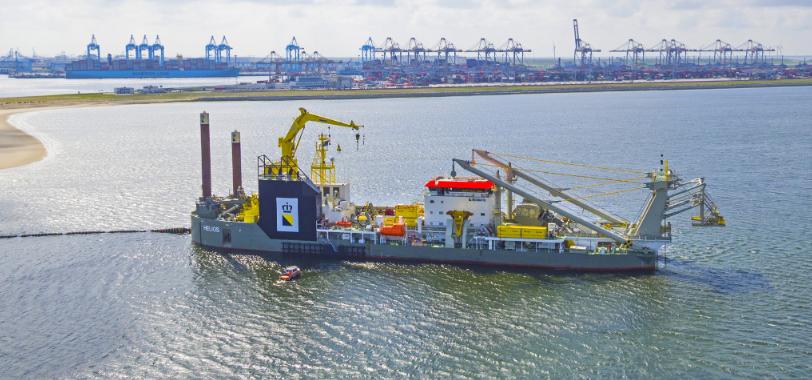Cutter Suction Dredgers made simple
A Cutter Suction Dredger (CSD) is a type of dredging equipment that uses a rotating cutter head to loosen and suck up sediment, soil, or other materials from the seabed or a body of water. The dredged material is then transported to a designated area through a pipeline.
Types of Cutter Suction Dredgers (CSDs)
There are several types of CSDs, each designed for specific applications and environments:
- Stationary CSD: A basic type of CSD that is mounted on a fixed platform or pontoon.
- Self-Propelled CSD: A CSD that is equipped with its own propulsion system, allowing it to move around freely.
- Trailing Suction Hopper Dredger (TSHD) with Cutter Head: A combination of a TSHD and a CSD, which can dredge and transport large volumes of material.
- Cutter Suction Dredger with Anchor Booms: A CSD that uses anchor booms to stabilize the dredger while operating in strong currents or deep waters.
- Cutter Suction Dredger with Spud Carriage: A CSD that uses a spud carriage to move the dredger forward while maintaining a stable position.
- Inland CSD: A smaller, more compact CSD designed for dredging in inland waterways, such as rivers, lakes, and canals.
- Deep Dredging CSD: A CSD designed for dredging in deep waters, often used for offshore dredging projects.
- Compact CSD: A smaller, more portable CSD designed for small-scale dredging projects or maintenance dredging.
- Amphibious CSD: A CSD that can operate in both water and on land, often used for dredging in shallow waters or coastal areas.
Cutter Suction Dredgers (CSDs) are versatile dredging equipment with a wide range of applications. Here are some of the primary uses of CSDs:
1. Port and Harbor Maintenance
CSDs help maintain navigable depths in ports and harbors by removing sediment, silt, and debris.
2. Beach Nourishment
CSDs pump sand onto eroded beaches to restore them and provide a natural barrier against storms and erosion.
3. Land Reclamation
CSDs are used to dredge and transport soil, sand, or other materials to create new land for development, infrastructure projects, or coastal protection.
4. River and Canal Dredging
CSDs help maintain navigable depths in rivers and canals by removing sediment, silt, and debris.
5. Mining and Quarrying
CSDs are used in mining and quarrying operations to extract minerals, sand, and gravel from underwater deposits.
6. Environmental Remediation
CSDs are used to clean up contaminated sediments, pollutants, and hazardous materials from waterways and aquatic ecosystems.
7. Offshore Construction
CSDs are used in offshore construction projects, such as building artificial islands, installing wind farms, and laying pipelines.
8. Flood Control and Prevention
CSDs help prevent flooding by dredging and removing sediment, debris, and other obstacles that can cause flooding.
9. Waterway Deepening
CSDs are used to deepen waterways, allowing larger vessels to navigate and increasing maritime trade.
10. Research and Scientific Studies
CSDs are used in research and scientific studies to collect sediment samples, study aquatic ecosystems, and monitor water quality.
These are just a few examples of the many uses of Cutter Suction Dredgers. The versatility and effectiveness of CSDs make them an essential tool in a wide range of industries and applications. It all depend on the capability of the people who decide to use them.
Cutter Suction Dredgers (CSDs) can be used to cut rocks, but with certain limitations and considerations.
Types of Rocks that can be Cut by CSDs
CSDs can effectively cut and dredge:
- Soft to medium-hard rocks: Such as sandstone, limestone, and claystone.
- Weathered or fractured rocks: CSDs can take advantage of existing fractures or weaknesses in the rock to cut and dredge more efficiently.
Limitations of CSDs in Cutting Rocks
However, CSDs may struggle to cut:
- Hard rocks: Such as granite, basalt, or quartzite, which can be too hard for the cutter head to effectively cut.
- Massive or unfractured rocks: CSDs may not be able to generate enough force or torque to cut through solid, unfractured rock.
- Boulders or large rocks: CSDs may not be able to handle large boulders or rocks that are too big for the cutter head to manage.
Specialized CSDs for Rock Cutting
To overcome these limitations, specialized CSDs have been developed:
- Rock cutter suction dredgers: These CSDs are equipped with more powerful cutter heads and specialized teeth designed specifically for cutting hard rocks.
- High-pressure water jets: Some CSDs use high-pressure water jets to help break up and cut rocks, reducing the load on the cutter head.
In summary, while CSDs can be used to cut rocks, their effectiveness depends on the type and hardness of the rock, as well as the specialized design and equipment of the CSD. This specialized design can be made only with adequate study of the area concerned

